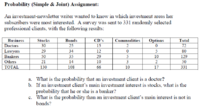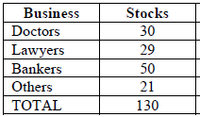jcooper015
New member
- Joined
- Aug 20, 2019
- Messages
- 14
Business | Stocks | Bonds | CD’s | Commodities | Options | Total |
| Doctors | 30 | 25 | 15 | 2 | 0 | 72 |
| Lawyers | 29 | 34 | 12 | 0 | 5 | 80 |
| Bankers | 50 | 35 | 29 | 5 | 10 | 129 |
| Others | 21 | 14 | 10 | 3 | 2 | 50 |
| TOTAL | 130 | 108 | 66 | 10 | 17 | 331 |

What you found for B is the probability that a client is interested in stocks or is a banker.A. 72/331=.2175 or 21.75%
B. (130/331+129/331)-50/331=not sure
C. 1-(108/331)=.6737 or 67.37%
No, that's the probability of being a banker who likes stocks (an "and" question).B. 50/331=.1510 or 15.10%
That's the probability of being a banker, period (like part a).Sorry
129/331=.3897 or 38.97
That seems to be an "or" assuming wrongly that bankers and stocks are independent.could B be
(130/331) x (129/331)-50/331=.0020 or 20 %
Look at the table.Can you try to explain in easier terms please! I am not very bright when it comes to this kinda thing. Is there a formula that you can give me so I can figure it out please. Then I can give you an answer to see if I am correct.
You need to stop making wild guesses.(130+50)/331=.5438
Here it is:Cover everything except the Stocks column, and think about the probability that someone in that smaller population is a banker.

